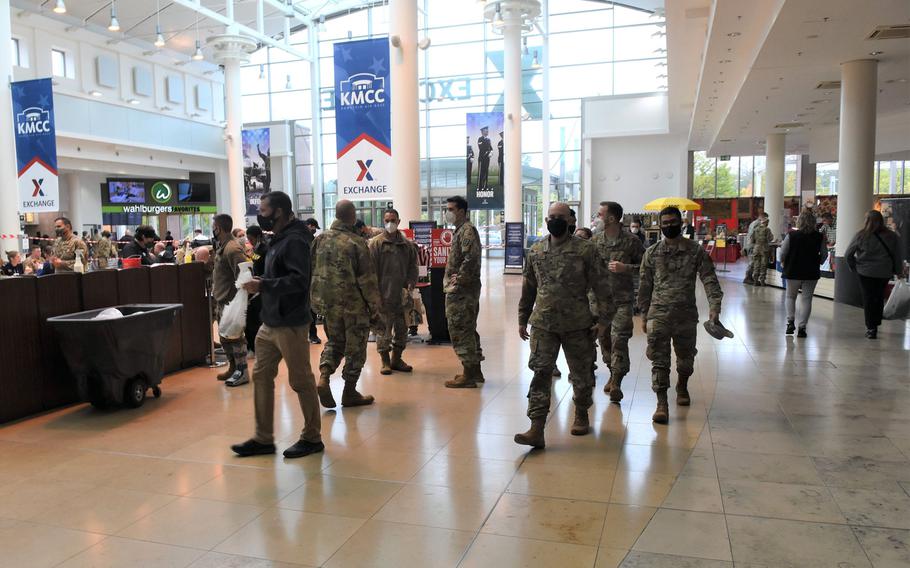Europe
US military figures obscured, often uncounted in Germany’s coronavirus totals
Stars and Stripes October 8, 2020

U.S. military personnel visit the Kaiserslautern Military Community Center at lunchtime on Tuesday, Oct. 6, 2020, at Ramstein Air Base, Germany. Tens of thousands of military personnel and their families live and work in Germany, but if they test positive for the coronavirus, they are not counted in official case numbers in several German communities. (Jennifer H. Svan/Stars and Stripes)
Stars and Stripes is making stories on the coronavirus pandemic available free of charge. See other free reports here. Sign up for our daily coronavirus newsletter here. Please support our journalism with a subscription.
KAISERSLAUTERN, Germany — Germany’s system of counting people infected with the coronavirus excludes communities with thousands of U.S. service members and their families, while informal agreements with local governments keep military case totals obscured from public view.
Several health departments don’t include U.S. military personnel in case totals because they consider them nonresidents, since most aren’t required to register with local governments under the terms of the status of forces agreement.
Others gather U.S. figures from local bases but include them within their overall figures – leaving the extent of infections on U.S. bases unclear to both Germans and Americans living in their communities.
The SOFA requires U.S. forces and German authorities to “promptly inform each other of an outbreak or suspected outbreak” of an infectious disease and measures taken to eliminate it.
But patchwork interpretations of what to do with coronavirus data have led to disparities. And while U.S. figures are only a sliver of German totals, the data reported to national and global agencies often doesn’t include them.
In Stuttgart, a metropolitan area of about 2 million and home to 28,000 Americans, including U.S. European Command, Africa Command and special operations forces, multiple city spokespeople did not know that the U.S. military reports case information to their health authority.
“The largest part of the Army’s service members lives on base and therefore they are not in our range of authority,” said Martin Thronberens, a city spokesman.
But that isn’t the case — on base housing is very limited at most U.S. bases in the country. About 30% of the Stuttgart military community lives in 1,300 on-base units, while the rest live off-base, the Army said in June.
The U.S. sends case totals to Stuttgart and the suburbs of Boeblingen and Esslingen, military health officials said Thursday. In March, Stuttgart had more than 100 cases and was among the hardest-hit U.S. bases in the world.
But Thronberens said those figures aren’t sent to the Robert Koch Institute, Germany’s national health agency.
In Hohenfels, where thousands of soldiers train, health officials hear from the U.S. military at least once a week and are notified of any positive cases, said Michael Gottschalk, a spokesman for the region’s Neumarkt health district.
However, the district doesn’t send the information to higher agencies unless the Americans are registered with a city hall, Gottschalk said. Aside from not being required to register, military lawyers have discouraged it, because registration has spurred some local German tax authorities to attempt to collect German income tax on U.S. military paychecks.
In the Spangdahlem, Grafenwoehr and Vilseck communities, the military shares case figures but they aren’t included in the district’s statistics, German officials in each of those areas said.
Garmisch-Partenkirchen, where a recent outbreak was tied to an American woman working at the military’s Edelweiss Lodge and Resort, does include the military’s figures in its reports to national authorities, though not as a separate statistic, spokesman Stephen Scharf said.
The only place in Germany where the public has any statistical idea of how U.S. military communities are faring is Kaiserslautern, a district and city of about 200,000 people and home to tens of thousands of military personnel and families.
Of the 574 total cases recorded in Kaiserslautern’s city and surrounding district, 47 have been attributed to U.S. armed forces, data posted regularly by a district commissioner on Facebook shows. On Tuesday, reports of eight new cases meant that 11 of the 54 active cases, which aren’t broken down by base, belonged to U.S. personnel.
The lack of transparency on how many infections are attributed to U.S. forces has its roots in an April order from Defense Secretary Mark Esper, which said not to release infection figures locally as an operational security measure.
“Based on DoD guidance, we ask that local health authorities only release our COVID numbers as part of their overall cases for the community,” Lt. Cmdr. Russ Wolfkiel, a EUCOM spokesman, said in an emailed statement.
German authorities have acceded to that. But Esper’s order has been interpreted differently among overseas military commands, particularly in Asia.
In Japan, some bases report the daily infection figure on their Facebook pages and state how the infection was traced.
U.S. Forces Korea has effectively interpreted Esper’s order as barring the reporting of aggregate figures for confirmed cases and the number of people in quarantine. But they do announce the number of people who have the virus or have recovered.
Some Europe-based commands have at times indicated to Stars and Stripes that they’d like to release more data, if only to show that their efforts to combat the coronavirus have proven successful. But after at least one command was chastised by the Pentagon for providing data at a virtual town hall meeting after the Esper order, they’ve been circumspect.
There’s no indication that Germany plans to create uniform requirements for reporting or that EUCOM will make any changes.
“We continue to work closely with the public health authorities at the local and installation levels and share information about positive cases with those authorities, as ultimately our bases are part of the larger host nation community,” Wolfkiel said.
Stars and Stripes reporter John Vandiver contributed to this report.
svan.jennifer@stripes.com
Twitter: @stripesktown
kloeckner.marcus@stripes.com